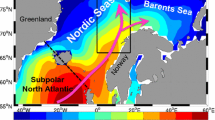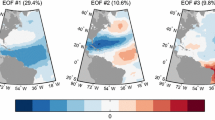Abstract
We explore the predictability of tropical Atlantic sea surface temperature (SST) and the potential influence of climate model bias on SST predictions over the tropical Atlantic. Two statistical methods are used to examine the skill in forecasting tropical Atlantic SST anomalies (SSTAs): linear inverse modeling (LIM) and analogue forecast (AF). The statistical models are trained either with observations or with data from two control integrations of the Kiel Climate Model (KCM), which only differ with respect to the resolution of its atmospheric component. Observed SSTAs suggest that Tropical Atlantic climatic changes are potentially predictable at lead times of up to 6 months over large parts of the Tropical Atlantic. The SSTAs from the KCM version employing a high-resolution atmosphere model (KCM-HRES) is potentially predictable at a level comparable to that derived from the observations, whereas the SSTAs from the KCM version employing a low-resolution atmosphere model (KCM-LRES) is considerably less potentially predictable. We show that the enhanced potential predictability in the former KCM version can be very likely related to the improved representation of ENSO-like dynamics and its seasonality. We used the statistical models in true forecast mode, i.e. the prediction schemes were trained from data independent of the forecast period. Using observed SSTAs to train the LIM yields significant skill in forecasting observed SSTAs at lead times of up to 4 months across all calendar months, which is mostly restricted to the northern and equatorial western Tropical Atlantic. Similar patterns, but with lower skill, are found when the models’ SSTAs are used, in which LIM trained with the KCM-HRES generally yields higher skills than that from the KCM-LRES. Applying AF yields significant skills in predicting observed SSTAs over the same regions, but the forecast skills are considerably smaller. When the SSTAs together with either sea level pressure (SLP) anomalies or dynamic sea level (DSL) anomalies from the KCM are used to construct the statistical models, the prediction of observed equatorial Atlantic SSTAs can be improved, with significant skill enhancement at lead times of up to 4 months in limited regions. An optimal initial SSTA pattern is found, which results in the largest transient anomaly growth over the entire domain. Independent of external forces, this amplification is developed internally; meaning that the seasonal forecast might be more sensitive to initial conditions than currently thought.















Similar content being viewed by others
References
Barnett TP, Preisendorfer RW (1978) Multifield analog prediction of short-term climate fluctuations using a climate state vector. J Atmos Sci. https://doi.org/10.1175/1520-0469(1978)035<1771:mapost>2.0.co;2
Barnston AG, Tippett MK, van den Dool HM, Unger DA (2015) Toward an improved multimodel ENSO prediction. J Appl Meteorol Climatol 54:1579–1595. https://doi.org/10.1175/JAMC-D-14-0188.1
Boer GJ (2004) Long time-scale potential predictability in an ensemble of coupled climate models. Clim Dyn 23:29–44. https://doi.org/10.1007/s00382-004-0419-8
Boer GJ, Boer GJ (2009) Changes in interannual variability and decadal potential predictability under global warming. J Clim 22:3098–3109. https://doi.org/10.1175/2008JCLI2835.1
Chang P, Saravanan R, Ji L (2003) Tropical Atlantic seasonal predictability: the roles of El Niño remote influence and thermodynamic air-sea feedback. Geophys Res Lett 30:n/a-n/a. https://doi.org/10.1029/2002GL016119
Compo GP, Sardeshmukh PD (2010) Removing ENSO-related variations from the climate record. J Clim. https://doi.org/10.1175/2009JCLI2735.1
Davey M, Huddleston M, Sperber K et al (2002) STOIC: a study of coupled model climatology and variability in tropical ocean regions. Clim Dyn. https://doi.org/10.1007/s00382-001-0188-6
Ding H, Keenlyside NS, Latif M (2010) Equatorial Atlantic interannual variability: role of heat content. J Geophys Res Ocean. https://doi.org/10.1029/2010JC006304
Ding H, Greatbatch RJ, Latif M, Park W (2015) The impact of sea surface temperature bias on equatorial Atlantic interannual variability in partially coupled model experiments. Geophys Res Lett. https://doi.org/10.1002/2015GL064799
Ding H, Newman M, Alexander MA, Wittenberg AT (2018) Skillful climate forecasts of the tropical Indo-Pacific Ocean using model-analogs. J Clim JCLI-D-17–0661.1. https://doi.org/10.1175/JCLI-D-17-0661.1
Dippe T, Greatbatch RJ, Ding H (2018) On the relationship between Atlantic Niño variability and ocean dynamics. Clim Dyn 51:597–612. https://doi.org/10.1007/s00382-017-3943-z
Enfield DB, Mayer DA (1997) Tropical atlantic sea surface temperature variability and its relation to El Niño-Southern Oscillation. J Geophys Res C Ocean 102:929–945. https://doi.org/10.1029/96JC03296
Exarchou E, Prodhomme C, Brodeau L et al (2018) Origin of the warm eastern tropical Atlantic SST bias in a climate model. Clim Dyn 51:1819–1840. https://doi.org/10.1007/s00382-017-3984-3
Farrell B (1988) Optimal excitation of neutral Rossby waves. J Atmos Sci. https://doi.org/10.1175/1520-0469(1988)045%3c0163:OEONRW%3e2.0.CO;2
Grodsky SA, Carton JA, Nigam S, Okumura YM (2012) Tropical Atlantic biases in CCSM4. J Clim. https://doi.org/10.1175/JCLI-D-11-00315.1
Harlaß J, Latif M, Park W (2015) Improving climate model simulation of tropical Atlantic sea surface temperature: the importance of enhanced vertical atmosphere model resolution. Geophys Res Lett. https://doi.org/10.1002/2015GL063310
Harlaß J, Latif M, Park W (2018) Alleviating tropical Atlantic sector biases in the Kiel climate model by enhancing horizontal and vertical atmosphere model resolution: climatology and interannual variability. Clim Dyn. https://doi.org/10.1007/s00382-017-3760-4
Hasselmann K (1988) PIPs and POPs: the reduction of complex dynamical systems using principal interaction and oscillation patterns. J Geophys Res. https://doi.org/10.1029/JD093iD09p11015
Hawkins E, Robson J, Sutton R et al (2011) Evaluating the potential for statistical decadal predictions of sea surface temperatures with a perfect model approach. Clim Dyn 37:2495–2509. https://doi.org/10.1007/s00382-011-1023-3
Horton P, Obled C, Jaboyedoff M (2017) The analogue method for precipitation prediction: Finding better analogue situations at a sub-daily time step. Hydrol Earth Syst Sci. https://doi.org/10.5194/hess-21-3307-2017
Huang B, Banzon VF, Freeman E, et al (2015) Extended reconstructed sea surface temperature version 4 (ERSST.v4). Part I: upgrades and intercomparisons. J Clim. https://doi.org/10.1175/JCLI-D-14-00006.1
Huddart B, Subramanian A, Zanna L, Palmer T (2017) Seasonal and decadal forecasts of Atlantic Sea surface temperatures using a linear inverse model. Clim Dyn. https://doi.org/10.1007/s00382-016-3375-1
Keenlyside NS, Latif M (2007) Understanding equatorial atlantic interannual variability. J Clim. https://doi.org/10.1175/JCLI3992.1
Latif M, Graham NE (1992) How much predictive skill is contained in the thermal structure of an oceanic GCM? J Phys Oceanogr. https://doi.org/10.1175/1520-0485(1992)022%3c0951:HMPSIC%3e2.0.CO;2
Lee DE, Chapman D, Henderson N et al (2016) Multilevel vector autoregressive prediction of sea surface temperature in the North Tropical Atlantic Ocean and the Caribbean Sea. Clim Dyn 47:95–106. https://doi.org/10.1007/s00382-015-2825-5
Madec G (2008) NEMO, the ocean engine. Technical report, Institut Pierre Simon Laplace (IPSL), France
Martinez-Villalobos C, Vimont DJ, Penland C et al (2018) Calculating state-dependent noise in a linear inverse model framework. J Atmos Sci 75:479–496. https://doi.org/10.1175/JAS-D-17-0235.1
Mcdermott PL, Wikle CK (2016) A model-based approach for analog spatio-temporal dynamic forecasting. Environmetrics. https://doi.org/10.1002/env.2374
Moore AM, Kleeman R (2001) The differences between the optimal perturbations of coupled models of ENSO. J Clim. https://doi.org/10.1175/1520-0442(2001)014%3c0138:TDBTOP%3e2.0.CO;2
Mullan AB, Thompson CS (2006) Analogue forecasting of New Zealand climate anomalies. Int J Climatol. https://doi.org/10.1002/joc.1261
Nnamchi HC, Li J, Kucharski F et al (2015) Thermodynamic controls of the Atlantic Niño. Nat Commun. https://doi.org/10.1038/ncomms9895
Park W, Keenlyside N, Latif M et al (2009) Tropical pacific climate and its response to global warming in the Kiel climate model. J Clim. https://doi.org/10.1175/2008JCLI2261.1
Penland C (1989) Random forcing and forecasting using principal oscillation pattern analysis. Mon Weather Rev. https://doi.org/10.1175/1520-0493(1989)117%3c2165:RFAFUP%3e2.0.CO;2
Penland C, Magorian T (1993) Prediction of Niño 3 Sea surface temperatures using linear inverse modeling. J Clim. https://doi.org/10.1175/1520-0442(1993)006%3c1067:PONSST%3e2.0.CO;2
Penland C, Matrosova L (1998) Prediction of Tropical Atlantic Sea surface temperatures using linear inverse modeling. J Clim 11:483–496
Penland C, Matrosova L (2006) Studies of El Niño and interdecadal variability in tropical sea surface temperatures using a nonnormal filter. J Clim. https://doi.org/10.1175/JCLI3951.1
Penland C, Sardeshmukh PD (1995) The optimal growth of tropical sea surface temperature anomalies. J Clim 8:1999–2024
Richter I, Xie SP, Behera SK et al (2014) Equatorial Atlantic variability and its relation to mean state biases in CMIP5. Clim Dyn. https://doi.org/10.1007/s00382-012-1624-5
Richter I, Doi T, Behera SK, Keenlyside N (2018) On the link between mean state biases and prediction skill in the tropics: an atmospheric perspective. Clim Dyn. https://doi.org/10.1007/s00382-017-3809-4
Steinig S, Harlaß J, Park W, Latif M (2018) Sahel rainfall strength and onset improvements due to more realistic Atlantic cold tongue development in a climate model. Sci Rep. https://doi.org/10.1038/s41598-018-20904-1
Stockdale TN, Balmaseda MA, Vidard A (2006) Tropical Atlantic SST prediction with coupled ocean-atmosphere GCMs. J Clim 19:6047–6061. https://doi.org/10.1175/JCLI3947.1
Tziperman E, Ioannou PJ (2002) Transient growth and optimal excitation of thermohaline variability. J Phys Oceanogr 32:3427–3435. https://doi.org/10.1175/1520-0485(2002)032%3c3427:TGAOEO%3e2.0.CO;2
Tziperman E, Zanna L, Penland CC (2008) Nonnormal thermohaline circulation dynamics in a coupled ocean-atmosphere GCM. J Phys Oceanogr 38:588–604. https://doi.org/10.1175/2007JPO3769.1
Vimont DJ (2012) Analysis of the Atlantic meridional mode using linear inverse modeling: Seasonality and regional influences. J Clim. https://doi.org/10.1175/JCLI-D-11-00012.1
von Storch H, Bruns T (1988) Principal oscillation pattern analysis of the 30-to 60-day oscillation in general circulation model equatorial troposphere. J Geo. https://doi.org/10.1029/JD093iD09p11022
Wahl S, Latif M, Park W, Keenlyside N (2011) On the tropical Atlantic SST warm bias in the Kiel climate model. Clim Dyn 36:891–906. https://doi.org/10.1007/s00382-009-0690-9
Xie S-P, Carton JA (2004) Tropical Atlantic variability: patterns, mechanisms, and impacts. Geophy Monogr Ser. https://doi.org/10.1029/147gm07
Xu Z, Chang P, Richter I et al (2014) Diagnosing southeast tropical Atlantic SST and ocean circulation biases in the CMIP5 ensemble. Clim Dyn. https://doi.org/10.1007/s00382-014-2247-9
Zanna L, Zanna L (2012) Forecast skill and predictability of observed atlantic sea surface temperatures. J Clim 25:5047–5056. https://doi.org/10.1175/JCLI-D-11-00539.1
Zebiak SE (1993) Air-sea interaction in the equatorial atlantic region. J Clim. https://doi.org/10.1175/1520-0442(1993)006%3c1567:AIITEA%3e2.0.CO;2
Acknowledgements
Xuewei Li is a PhD student, supported by the China Scholar-ship Council (CSC). The KCM model integrations were conducted at the Computer Center of Kiel University. This work was supported by the European Union’s PREFACE (FP7/2007–2013, no. 603521) Project and the SPACES/SACCUS (No. 03G0837A) and RACE II Project of BMBF (Grant Agreement No. 03F0729C) project of the BMBF. We acknowledge two anonymous reviewers for their constructive comments and suggestions for improving the manuscript.
Author information
Authors and Affiliations
Corresponding author
Additional information
Publisher's Note
Springer Nature remains neutral with regard to jurisdictional claims in published maps and institutional affiliations.
Electronic supplementary material
Below is the link to the electronic supplementary material.
Rights and permissions
About this article
Cite this article
Li, X., Bordbar, M.H., Latif, M. et al. Monthly to seasonal prediction of tropical Atlantic sea surface temperature with statistical models constructed from observations and data from the Kiel Climate Model. Clim Dyn 54, 1829–1850 (2020). https://doi.org/10.1007/s00382-020-05140-6
Received:
Accepted:
Published:
Issue Date:
DOI: https://doi.org/10.1007/s00382-020-05140-6




